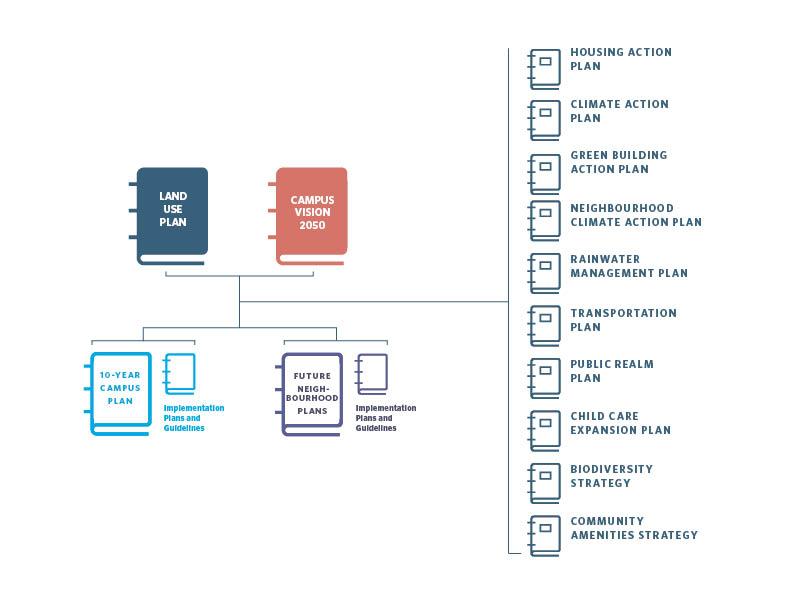The content on this page was last updated in July 2024.
For the latest updates, visit the News & Events section.
The Vision will be brought to life over the next 30 years through the development of supporting plans, policies and technical analysis undertaken with community members, researchers and academics, Musqueam and external jurisdictions and partners.
Policies & Plans

The Vision supports the academic mission, values and priorities of the university by providing a long-term, aspirational framework for physical growth and change on the campus. Implementing the Vision will involve many UBC policies and plans aligned with its priorities.
Learn more about the relationship between Campus Vision 2050 and other plans and policies:
Working with Musqueam
This Vision document represents the broad intention of the university. Through subsequent, more detailed planning, Musqueam and UBC will work together to manage existing and potential impacts of growth on local services and ecology on the peninsula.
UBC and Musqueam Indian Band are working together to transform their long-standing relationship with a Relationship Agreement. This is an important part of UBC’s institutional commitment to deepening the university’s relationship with Musqueam and to reconciliation more broadly. Through the Relationship Agreement, UBC and Musqueam are co-developing a comprehensive framework for engaging Musqueam on land use initiatives to better understand and incorporate Musqueam values, needs and interests into planning.
Working with the UNA
The University Neighbourhoods Association (UNA) has been a key stakeholder in Campus Vision 2050 and is an important partner for UBC’s current and future neighbourhoods. UBC will continue to collaborate with the UNA through the Neighbours’ Agreement, UBC-UNA Liaison Committee, and regular UNA Board engagement. UBC is also committed to formal UNA involvement in planning for future neighbourhoods, the review of future neighbourhood development proposals, and the handover of future neighbourhood facilities and amenities for UNA service delivery.
Working with Other Agencies
UBC will continue to work with the province, TransLink, the City of Vancouver, Metro Vancouver, Vancouver Fire and Rescue Services, the RCMP, the Vancouver School Board, Vancouver Coastal Health, and other partners to deliver on areas of shared interest including: housing affordability, rapid transit, roads, public safety, schools, and infrastructure. This includes making sure services are in place to respond to growing community needs and collaborating with Musqueam Indian Band to engage other agencies on areas of shared interest. It also includes working together with the University Endowment Lands and Metro Vancouver to respect the character of the surrounding neighbourhoods, protecting the sensitive ecology of Pacific Spirit Regional Park, and mitigate potential development impacts on downstream habitats and the adjacent cliffs.
Phasing
While specific timing, financing and servicing needs for future growth will be determined through supplementary plans and policies, development activities are generally expected within these timeframes.
Short Term Phasing
Next 10 Years
- Implement projects from UBC’s Capital Projects Priority List, including planning for replacement facilities such as Chemistry, Applied One, Medicine One and Math, and planning for seismically vulnerable facilities.
- Begin implementing 3,300 new and 1,000 replacement student beds and supporting amenities and services like child care.
- Amend the Neighbourhood Plan for Wesbrook Place with an expanded boundary and development allocations, and complete Wesbrook Place development.
- Finalize the plan for Stadium Neighbourhood.
- Identify which neighbourhood(s) will be built next and work with the community to develop and/or ammend Neighbourhood Plan(s).
- Deliver services and amenities in tandem with growth in population.
Long Term Phasing
Years 10-30
- Develop remaining neighbourhood plans.
- Deliver subsequent academic and neighbourhood development.
- Update the Land Use Plan in alignment with future updates to the Housing Action Plan and other relevant policies, including consideration of new areas for additional development and redevelopment.
- Update the 10-Year Campus Plan, including planning for replacement facilities.